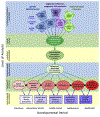Psychiatry and developmental psychopathology: Unifying themes and future directions
- PMID: 30415196
- PMCID: PMC6296473
- DOI: 10.1016/j.comppsych.2018.10.014
Psychiatry and developmental psychopathology: Unifying themes and future directions
Abstract
In the past 35 years, developmental psychopathology has grown into a flourishing discipline that shares a scientific agenda with contemporary psychiatry. In this editorial, which introduces the special issue, we describe the history of developmental psychopathology, including core principles that bridge allied disciplines. These include (1) emphasis on interdisciplinary research, (2) elucidation of multicausal pathways to seemingly single disorders (phenocopies), (3) description of divergent multifinal outcomes from common etiological start points (pathoplasticity), and (4) research conducted across multiple levels of analysis spanning genes to environments. Next, we discuss neurodevelopmental models of psychopathology, and provide selected examples. We emphasize differential neuromaturation of subcortical and cortical neural networks and connectivity, and how both acute and protracted environmental insults can compromise neural structure and function. To date, developmental psychopathology has placed greater emphasis than psychiatry on neuromaturational models of mental illness. However, this gap is closing rapidly as advances in technology render etiopathophysiologies of psychopathology more interrogable. We end with suggestions for future interdisciplinary research, including the need to evaluate measurement invariance across development, and to construct more valid assessment methods where indicated.
Keywords: Developmental psychopathology; Equifinality; Interdisciplinary; Multifinality; Neurodevelopment; Psychiatry.
Copyright © 2018 Elsevier Inc. All rights reserved.
Figures




References
-
- Achenbach TM. Developmental psychopathology. New York: Ronald Press; 1974.
-
- Cicchetti D, ed. Development and psychopathology. New York: Cambridge University Press; https://www.cambridge.org/core/journals/development-and-psychopathology
-
- Beauchaine TP, Goodman SH, eds. Ontogenic process models of psychopathology [special section]. J Abn Psychology, 2015; 124.
-
- Tackett JL, Sharp C, eds. A developmental psychopathology perspective on personality disorder [special issue]. J Pers Disord, 2014; 28. - PubMed
-
- Sonuga-Barke E, ed. Annual Research Review: Reimagining the environment in developmental psychopathology: From molecules to effective treatments [special issue]. J Child Psychl Psyc. 2018; 59. - PubMed
Publication types
MeSH terms
Grants and funding
LinkOut - more resources
Full Text Sources
Miscellaneous

